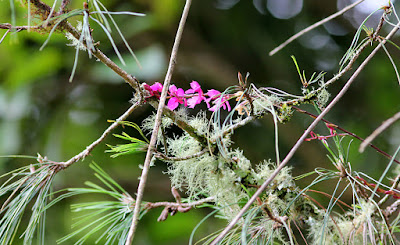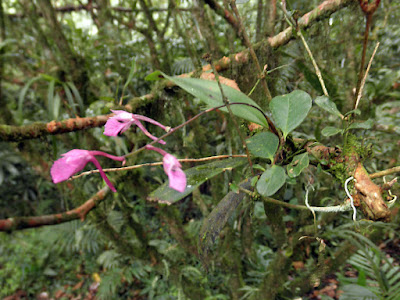Comparettia falcata is widely distributed but rare in Mexico, Central America, North America and the Caribbean. These plants grow on trees and shrubs in humid rainforests, usually at high altitudes...
Comparettia falcata also called as The Sickle-Shaped Comparettia, Comparettia cryptocera, Comparettia erecta, Comparettia falcata f. alba, Comparettia falcata var. paulensis, Comparettia paulensis, Comparettia rosea, Comparettia venezuelana, Ionopsis orchioides, Orchis pauciflora, is a species of the genus Comparettia. This species was described by Eduard Friedrich Poeppig & Stephan Ladislaus Endlicher in 1836.
IDENTIFY COMPARETTIA FALCATA
Comparettia falcata is widely distributed but rare in Mexico, Central America, North America and the Caribbean. These plants grow on trees and shrubs in humid rainforests, usually at high altitudes. In Mexico, these plants are found in the states of Veracruz, Oaxaca and Chiapas at heights of 1000-2200 m. In Guatemala, they grow in the departments of Alta Verapaz (near Cobán), Chiquimula, Guatemala, Huehuetenango, San Marcos, Quiche and Sololá below 1800 m. In Honduras, they are found in the department of Comayagua at an altitude of 1350-2000 m. In Nicaragua this orchid is known in the departments of Jinotega and Matagalpa, where it occurs at heights 1300-1400 m. In Costa Rica, the plants were encountered in the departments of Alajuela, Cargago and Heredia, where they grow at heights 1000-2100 m. In Venezuela, they grow in the Federal District, in the states of Aragua, Carabobo, Merída and Miranda at an altitude of 750-2300 m, and in the Amazon Territory at an altitude of 1,250 m. In Ecuador, they appear in various places, from the border with Colombia to the border with Peru. They grow on trees in humid forests, often on Guava trees, at altitudes of 730-1500 m. They were found in the provinces of Carchi, El Oro, Morona-Santiago, Napo, Pastaza, Pichincha, Tungurahua and Zamora-Chinchipe. In Peru, the plants were found in the department of Huánoco near Cuchero (Cochero) between Cassapi and Pampayaco (Pampayacu) and Amazonas at 1350-1600 m. In the Caribbean they were found in the Dominican Republic at an altitude of 1350 m. In Puerto Rico it grows on shrubs, branches and branches of branches in moist forests at heights of 700-970 m.
It is a small sized, caespitose, warm to cool growing epiphyte or occasional lithophyte, which reaching 20 cm in height, with an oblong-cylindric, lightly compressed, 1-4 cm long and up to 1 cm in diameter pseudobulb with an elliptic, oblong-lanceolate, 3-17 cm long and 1-5 cm wide single leaf.
The Sickle-Shaped Comparettia blooms in the late winter to early spring to summer on a newly matured pseudobulb and has a delicate, basal, erect then arcuate, more than 30 cm, sometimes irregularly branched, racemose inflorescence with up to 8 flowers that are held well above the leaves. The flowers have up to 1.5 cm in diameter measured across the slightly distributed petals of the inner whorl and about 2 cm in length from the top of the dorsal petal to the tip of the broadly decomposed, nodule-shaped margin. The effective flowers have a deep pink color, they are usually slightly paler in the middle with darker veins.
COMPARETTIA FALCATA CARE AND CULTURE
Cultural information should only be used as a guide, and should be to be adapted to suit you. Your physical location; where you grow your plants, how much time you have to devote to their care, and many other factors, will need to be taken into account. Only then can you decide on the cultural methods that best suit you and your plants.
Light:
Comparettia falcata needs a light level of 12000-18000 lux. These plants require a shaded position with filtered or diffused light. They should be protected from direct sunlight, especially in the noon hours. Strong air movement should be ensured all the time.
Temperature:
It is a plant with moderate thermal requirements. The average temperature of the summer day is 24-26 ° C, night 14-15 ° C, which gives a daily difference of 10-11 ° C. The average temperature of the winter day is 22-23 ° C, night 10-11 ° C, giving a daily difference of 11-13 ° C.
Humidity:
The Sickle-Shaped Comparettia needs the humidity of 80-85% throughout the year.
Substrate, growing media and repotting:
Comparettia falcata can be mounted on cork or tree fern rootstock if high humidity and watering are maintained at least once a day during the summer. When growing in pots, a loose and airy substrate such as bark of medium or large size, pieces of cork or tree-fern fiber is recommended. The pots should be as small as possible so that only the root ball can fit.
Watering:
In the natural habitat, rainfall is very abundant throughout the year. The cultivated plants should be abundantly watered during active growth, but excellent drainage must be ensured, and the roots must be almost dry before the next watering. In addition to the period of active growth, the amount of water can be reduced.
Fertilizer:
During the active growth, the plants should be fertilized every week 1/4-1/2 of the recommended dose of fertilizer for orchids.
Rest period:
Comparettia falcata in winter need less water, especially if they are grown in conditions of a short, dark day occurring in winter, but they can never dry up completely. Fertilization should always be reduced when the amount of water decreases. When new growths start to appear in spring, fertilization increases.















COMMENTS